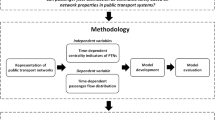Abstract
Ports provide a number of logistical choices concerning storage, onward transport and postponement. We investigate the flexibility offered by ports of a central location with respect to hinterland transport. This is illustrated through a case in which a number of alternative strategies are evaluated by means of simulation. We provide a simulation model and illustrate it with a case using detailed cost data, which allows us to quantify the value of the rerouting alternatives. A strategy that employs regional distribution centers coupled with a European Distribution Center results in the lowest cost per container. The superiority of this policy over standard centralized or decentralized distribution networks is largely based on the optimal balance between inventory and transportation cost, and the flexibility it offers.


Similar content being viewed by others
Notes
This assumption appears to be reasonable, because the countries we employ in the illustrative case do not include unbalanced concentrations of customer demand concentrated at one physical location.
As we did not have data for La Spezia and Southampton, we have selected the highest charge (Hamburg) and added a small premium to model the lack of economies of scale. No terminal handling charges were defined for the Shanghai terminal because they would not cause any difference in the results.
References
Baker, P. (2007) An exploratory framework of the role of inventory and warehousing in international supply chains. The International Journal of Logistics Management 18 (1): 64–80.
Beamon, B.M. (1999) Measuring supply chain performance. International Journal of Operations and Production Management 19 (3): 275–292.
Brooks, M.R. (1984) An alternative theoretical approach to the evaluation of liner shipping – Part I. situational factors. Maritime Policy & Management 11 (1): 35–43.
Brooks, M.R. (1985) An alternative theoretical approach to the evaluation of liner shipping Part II. choice criteria. Maritime Policy & Management 12 (2): 145–155.
Brooks, M.R. (1990) Ocean carrier selection criteria in a new environment. Logistics and Transportation Review 26 (4): 339–355.
Chopra, S. and Meindl, P. (2004) Supply Chain Management, 2nd edn. New-Jersey: Prentice-Hall.
Christiansen, M., Fagerholt, K. and Ronen, D. (2004) Ship routing and scheduling: Status and perspectives. Transportation Science 38 (1): 1–18.
de Langen, P. (2007) Port competition and selection in contestable hinterlands; the case of Austria. European Journal of Transport Infrastructure Research 7 (1): 1–14.
Google. (2008) Google maps. maps.google.nl, accessed in November 2008.
Huggins, E. and Olsen, T. (2003) Supply chain management with guaranteed delivery. Management Science 49 (9): 1154–1167.
International Monetary Fund. (April 2008) World Economic Outlook Database. Technical report.
Kim, K.H. and Kim, K.Y. (2007) Optimal price schedules for storage of inbound containers. Transportation Research Part B: Methodological 41 (8): 892–905.
L'Ecuyer, P., Meliani, L. and Vaucher, J. (2002) SSJ: A framework for stochastic simulation in java. In: E. Yücesan, C.-H. Chen, J.L. Snowdon and J.M. Charnes (eds.) Proceedings of the 2002 Winter Simulation Conference. San Diego, CA, IEEE Press, pp. 234–242.
Mangan, J., Lalwani, C. and Fynes, B. (2008) Port-centric logistics. The International Journal of Logistics Management 19 (1): 29–41.
McGinnis, M.A. (1979) Shipper attitudes towards freight transport choice. A factor analytic study. International Journal of Physical Distribution and Materials Management 10 (1): 25–34.
McGinnis, M.A. (1989) A comparative evaluation of freight transportation choice models. Transportation Journal 29 (2): 36–46.
Meixell, M.J. and Norbis, M. (2008) A review of the transportation mode choice and carrier selection literature. The International Journal of Logistics Management 19 (2): 183–211.
Naim, M.M., Potter, A.T., Mason, R.J. and Bateman, N. (2006) The role of transport flexibility in logistics provision. International Journal of Logistics Management 17 (3): 297–311.
Notteboom, T. (2004) Container shipping and ports: An overview. Review of Network [1] Economics 3 (2): 86–106.
Notteboom, T. and Rodrigue, J.-P. (2005) Port regionalization: Towards a new phase in port development. Maritime Policy & Management 32 (3): 297–313.
Ochtman, G., Dekker, R., van Asperen, E. and Kusters, W. (2009) Floating stocks in FMCG supply chains. International Journal of Physical Distribution and Logistics Management 39 (8): 632–648.
Olivier, D., Parola, F., Slack, B. and Wang, J.J. (2007) The time scale of internationalisation: The case of the container port industry. Maritime Economics & Logistics 9 (1): 1–34.
Pagh, J.D. and Cooper, M.C. (1998) Supply chain postponement and speculation strategies: How to choose the right strategy. Journal of Business Logistics 19 (2): 13–33.
Panayides, P.M. and Song, D.-W. (2008) Evaluating the integration of seaport container terminals in supply chains. International Journal of Physical Distribution & Logistics Management 38 (7): 562–584.
Pourakbar, M., Sleptchenko, A. and Dekker, R. (2009) The floating stock policy in fast moving consumer goods supply chains. Transportation Research E 45 (1): 39–49.
Robinson, R. (2002) Ports as elements in value-driven chain systems: The new paradigm. Maritime Policy & Management 29 (3): 241–255.
Sherbooke, C.C. (2004) Optimal Inventory Modeling of Systems: Multi-echelon Techniques, 2nd edn. Boston/Dordrecht/London: Kluwer Academic Publishers.
Slack, B. (1985) Containerization, inter-port competition, and port selection. Maritime Policy & Management 12 (4): 293–303.
Steenken, D., Voß, S. and Stahlbock, R. (2004) Container terminal operation and operations research – a classication and literature review. OR Spectrum 26 (1): 3–49.
Tongzon, J.L. (2009) Port choice and freight forwarders. Transportation Research Part E: Logistics and Transportation Review 45 (1): 186–195.
United Nations. (2002) Commercial Development of Regional Ports as Logistics Centres. Economic and Social Commission for Asia and the Pacific: United Nations Publications.
van der Horst, M.R. and de Langen, P.W. (2008) Coordination in hinterland transport chains: A major challenge for the seaport community. Maritime Economics & Logistics 10 (1): 108–129.
Veldman, S.J. and Bückmann, E.H. (2003) A model on container port competition: An application for the west European container hub-ports. Maritime Economics & Logistics 5 (1): 3–22.
Wallin, C., Rungtusanatham, M.J. and Rabinovich, E. (2006) What is the ‘right’ inventory management approach for a purchased item? International Journal of Operations & Production Management 26 (1/2): 50–68.
Wiegmans, B.W., Hoest, A.v.d. and Notteboom, T.E. (2008) Port and terminal selection by deep-sea container operators. Maritime Policy & Management 35 (6): 517–534.
Acknowledgements
The authors wish to thank Prof. Dr Peter de Langen (Port Authority of Rotterdam) for his valuable suggestions and cost estimates. We thank Joost Hengstmengel (MSc student at Erasmus University Rotterdam) for his implementation of a simulation model that provided the basis for the simulation model used in this article. Finally, we acknowledge the valuable feedback from the anonymous referees and the assistance Evgeny Kagan provided in making the revision.
Author information
Authors and Affiliations
Rights and permissions
About this article
Cite this article
van Asperen, E., Dekker, R. Centrality, flexibility and floating stocks: A quantitative evaluation of port-of-entry choices. Marit Econ Logist 15, 72–100 (2013). https://doi.org/10.1057/mel.2012.22
Published:
Issue Date:
DOI: https://doi.org/10.1057/mel.2012.22




